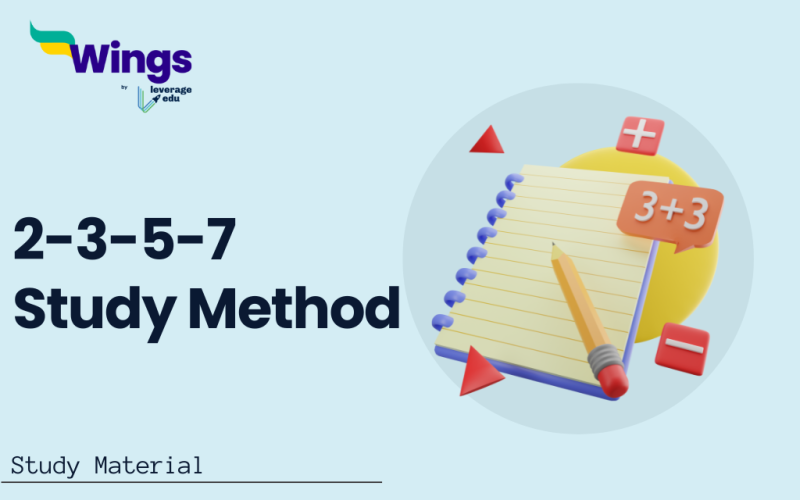Are you stressed out about exams and having trouble remembering pieces of information? Are you afraid of the last-minute rush that makes you forget things or information and think less clearly? The 2-3-5-7 study method is the key to success. This well-structured strategy of spaced repetition is scientifically proven to improve your memory and learning. Students can fight the forgetting curve and make sure that knowledge stays in their long-term memory by planning review meetings to happen at set times. Are you ready to ditch studying and do great on your next exam? Let’s look at the 2-3-5-7 study method and see how it can help you learn more.
Table of Contents
What is the 2-3-5-7 Study Method?
The 2-3-5-7 method uses the concept of regular repetition, a scientifically proven method for helping aspirants remember things. It works by strategically scheduling review meetings to happen at regular time intervals to fight the forgetting curve, which is the effect of forgetting things over time.
Here’s how it works:
- Mark your calendar: Begin by marking your exam date on a calendar.
- Plan Your Revisons: Working backwards from your exam date, schedule your revision sessions at specific intervals like 2 days, 3 days, 5 days, and 7 days before your exam.
For example, if your exam is on Friday, you’d schedule your exam revision sessions on Wednesday (7 days before), Monday (5 days before), Saturday (3 days before), and Thursday (2 days before).
Elements of 2-3-5-7 Study Method
The 2-3-5-7 study method is a spaced repetition plan that is meant to help you remember things better by reviewing them at the right times. Here’s a breakdown of the elements and what each number means.
2 Days
- This represents your initial revision after reading the information for the first time.
- The short breaks help your short-term memory hold onto the knowledgeable information.
- It’s like a quick revision to make sure you remember the main ideas before they fade.
3 Days
- Following a few days from the first revision, the second one serves as a follow-up.
- This helps move information from your short-term memory to your long-term memory, which helps you remember what you’ve learned.
5 Days
- The third revision has a little more space than the second revision.
- This extended interval helps you remember things and keeps you from losing them by giving your brain another chance to process the information.
7 Days
- The fourth revision marks the longest interval between revisions.
- By this point, with constant timed repeat, you should now be able to remember the knowledgeable information for a long time.
The main idea behind the 2-3-5-7 study method is the spacing effect, which is a well-studied effect that shows spaced-out practice sessions are better for memory and recall than studying right before the exam.
Also Read: How to Use Richard Feynman Learning Method for Studying?
Why Does the 2-3-5-7 Study Method Work?
By strategically revising the material before you fully lose it, this 2-3-5-7 strategy helps you overcome the difficulty of forgetting information. The memory trace is strengthened with each revision session, which increases the likelihood that it will be retained.
Here are some Benefits:
- Boost Long-Term Memory: Spaced repetition helps information transition from short-term to long-term memory, making it readily available for recall during exams.
- Stops Cramming: By spreading out your studying, you avoid the last-minute cramming that leads to information overload and forgetfulness.
- Improves Focus: Shorter, spaced-out sessions allow for better focus and retention compared to lengthy cramming sessions.
How to Make the 2-3-5-7 Study Method Work for You
The 2-3-5-7 study method is a good starting point for spaced study sessions, but to get the most out of it, here are some important things you can do.
- Do not just read over your notes. Use active recall techniques like practice questions, making notes, or explaining concepts to yourself out loud to solidify information.
- It might help to cram facts at first, but if you want to really remember something, you should try to understand it better.
- Break down large topics into smaller chunks for each revision session.
- Schedule your revision sessions at a time when you’re most focused and can avoid distractions.
The 2-3-5-7 study method is a helpful technique that may help you fight forgetfulness and improve your learning experience. Always keep in mind that consistency is the main key to performing well in exams. When you make spaced repetition a regular practice of your study, you will be well on your way to achieving success on your examinations.
Also Read: What is the Pomodoro Technique for Studying? How to Use It?
FAQ’s
If you use the 2357 method, you go over your first set of notes again on day one, then again on days two and three, and finally again on days five and seven.
The 2357 approach is a strategy that allows you to organize your study sessions in advance of the upcoming examinations.
Visual, auditory, read/write, and kinesthetic are the four main ways individuals learn.
RELATED BLOGS
This was all about the “2-3-5-7 Study Method”. For more such informative blogs, check out our Study Material Section, or you can learn more about us by visiting our Indian exams page.
 One app for all your study abroad needs
One app for all your study abroad needs













